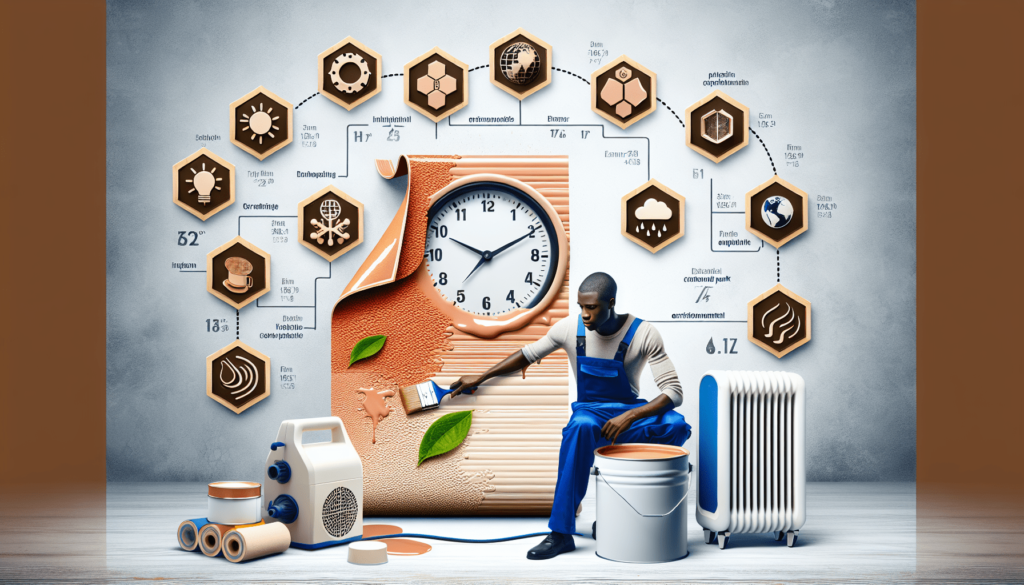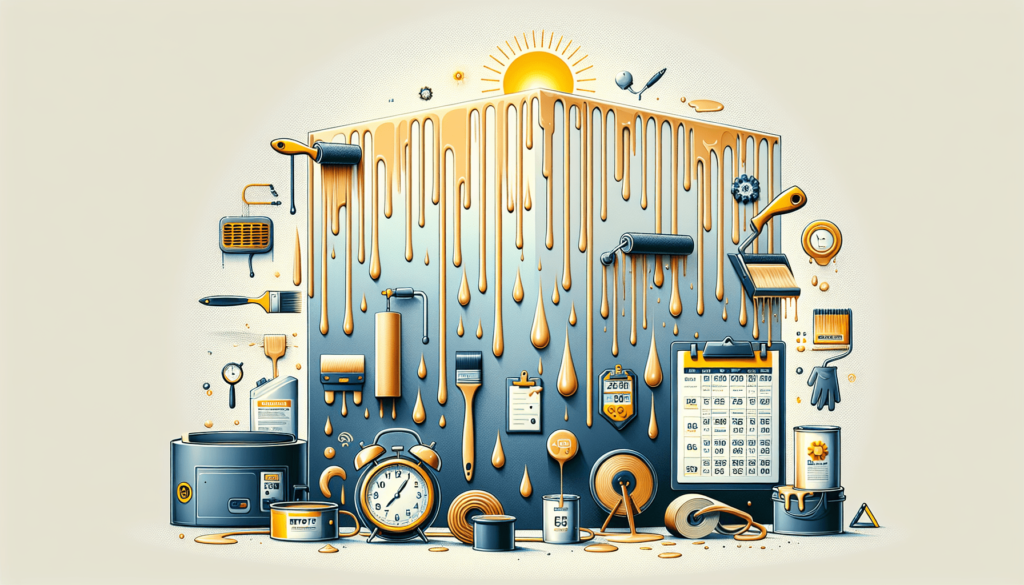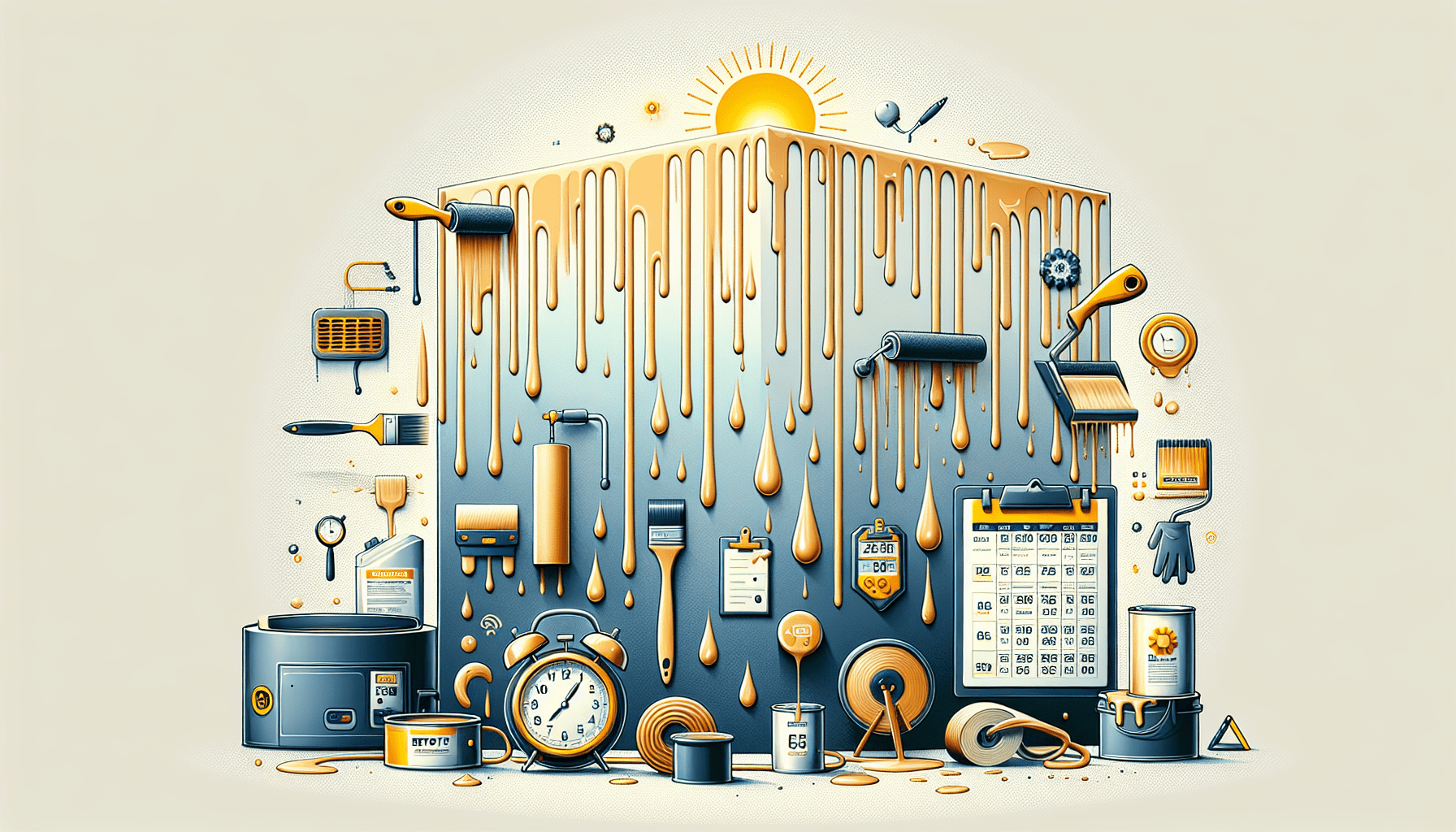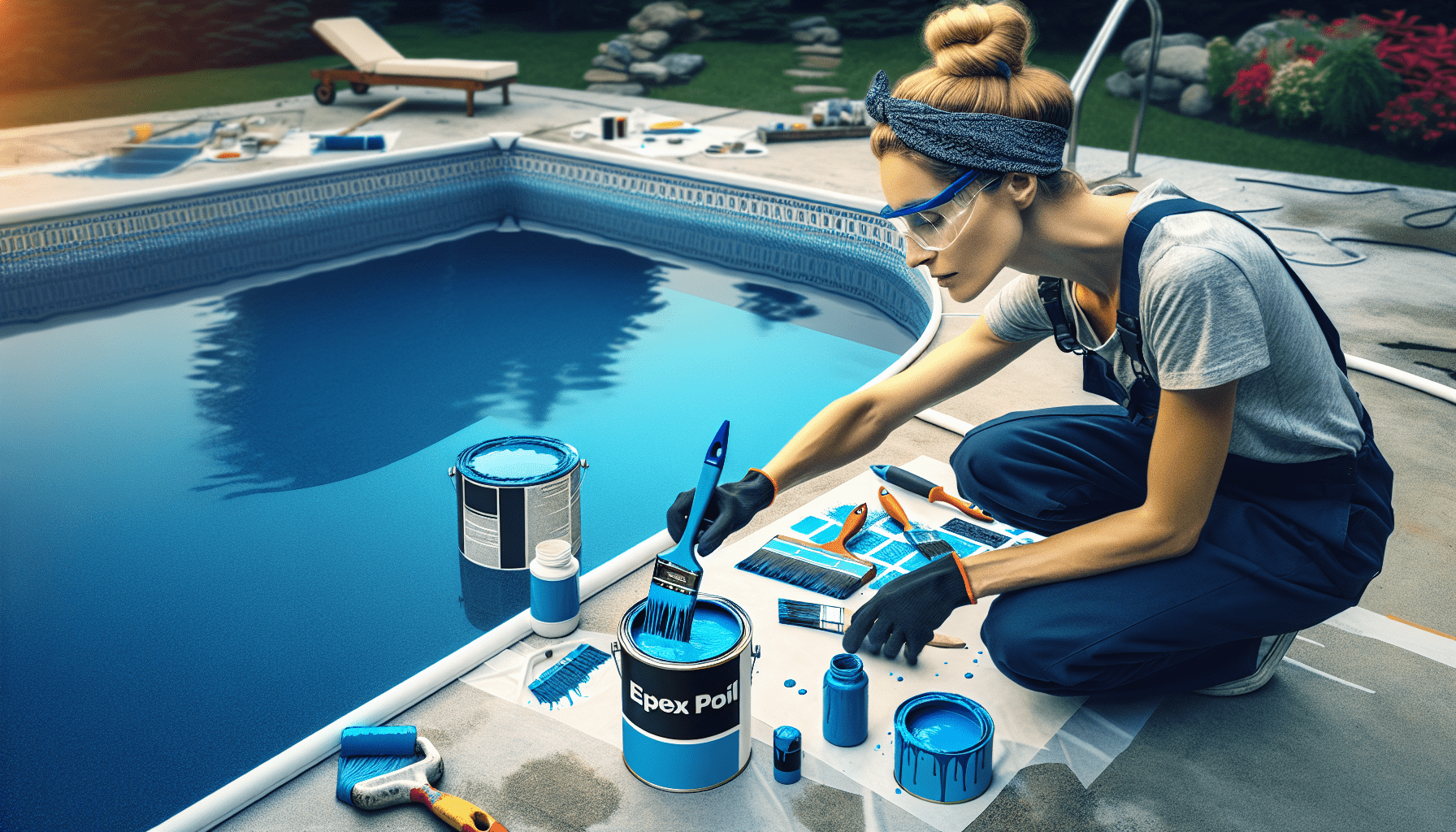Epoxy paint is a popular choice for many DIY projects due to its durability and attractive finish. However, one factor that often raises questions is the drying time. When it comes to epoxy paint, it is crucial to understand the timeframe required for proper drying in order to prevent any unwanted smudges or imperfections. In this article, we will explore the average drying time for epoxy paint and provide some helpful tips to ensure a successful application. By the end, you will have a clear understanding of how long it takes for epoxy paint to dry, allowing you to confidently tackle your next painting project.
Factors Affecting Epoxy Paint Drying Time
Epoxy paint drying time can vary depending on several factors. Understanding these factors is essential for achieving optimal drying results and ensuring the longevity and durability of the epoxy coating. The key factors that affect epoxy paint drying time are temperature and humidity, the type of epoxy paint used, the thickness of the epoxy coating, ventilation and airflow, and surface porosity. Let’s explore each of these factors in detail.
Temperature and Humidity
Temperature and humidity play a crucial role in the drying process of epoxy paint. Epoxy paint dries through both chemical reaction and evaporation of solvents. Higher temperatures accelerate the chemical reaction and evaporation, leading to faster drying times. Conversely, lower temperatures prolong the drying process.
Similarly, humidity affects the drying time of epoxy paint. High humidity levels slow down the evaporation of solvents, resulting in longer drying times. On the other hand, low humidity facilitates faster evaporation, expediting the drying process.
Type of Epoxy Paint
The type of epoxy paint used is another significant factor determining drying time. Different formulations of epoxy paints have varying drying characteristics. There are mainly three types of epoxy paints commonly used: water-based epoxy paint, solvent-based epoxy paint, and fast-curing epoxy paint.
Water-based epoxy paint typically has a longer drying time compared to solvent-based or fast-curing epoxy paints. Solvent-based epoxy paints contain volatile solvents that enhance drying time, whereas fast-curing epoxy paints are specifically formulated for rapid drying.
Thickness of Epoxy Coating
The thickness of the epoxy coating also affects the drying time. Thin coatings generally dry faster than thick ones. This is because thin coatings have a smaller volume, allowing solvents to evaporate more quickly. In contrast, thick coatings take longer to dry as the solvents trapped within the layers need more time to evaporate.
Additionally, multiple coats of epoxy paint can also extend the overall drying time. Each coat needs to dry fully before the next one can be applied, prolonging the drying process. It is essential to consider the recommended dry film thickness for the specific epoxy paint used to ensure proper drying and curing.
Ventilation and Airflow
Proper ventilation and airflow are crucial for optimal drying of epoxy paint. Good ventilation helps to carry away the evaporating solvents, facilitating faster drying. Insufficient ventilation can result in stagnant air, prolonging the drying process.
Using fans and dehumidifiers can significantly improve airflow and ventilation, expediting the drying time of epoxy paint. These devices help to enhance the evaporation of solvents and promote a consistent flow of air across the painted surface.
Surface Porosity
The porosity of the substrate on which epoxy paint is applied can also impact drying time. Porous surfaces, such as concrete or wood, tend to absorb more moisture from the epoxy paint, leading to longer drying times. The moisture absorption slows down the evaporation process, preventing the paint from drying as quickly as it would on non-porous surfaces.
Proper surface preparation is essential for porous substrates to minimize the effect of porosity on drying time. Preparing the surface by filling any cracks, applying a primer, or using a sealant can help create a smoother surface, reducing the porosity and enhancing the drying process.
Drying Time for Epoxy Paint
Understanding the different stages of epoxy paint drying can provide valuable insights into its overall drying time. Epoxy paint typically goes through several stages, including touch dry, recoat time, light foot traffic, heavy foot traffic, and spot cleaning. Let’s explore each of these stages.
Touch Dry
Touch dry refers to the stage when the epoxy paint has dried to the point where it is no longer tacky to the touch. At this stage, the paint may still be soft, and caution should be exercised to avoid any damage. The touch dry stage is an important milestone as it indicates that the paint has reached initial curing and can be handled without causing significant harm.
Factors such as temperature, humidity, and the type of epoxy paint used influence the duration it takes for epoxy paint to become touch dry. In optimal conditions, epoxy paint can become touch dry within a few hours to overnight.
Recoat Time
Recoat time refers to the time required between applying subsequent coats of epoxy paint. It is crucial to adhere to the recommended recoat time to ensure proper adhesion and a seamless finish. Failure to wait the appropriate recoat time may lead to bubbling, delamination, or other defects in the finished coating.
The recoat time is dependent on various factors such as the type of epoxy paint, temperature, humidity, and the thickness of the previous coat. Typically, epoxy paints have specified recoat times ranging from a few hours to several days. It is essential to follow the manufacturer’s guidelines and recommendations for the specific epoxy paint used.
Light Foot Traffic
Light foot traffic refers to the stage when the epoxy paint has dried sufficiently to withstand minimal foot traffic. This stage usually comes after the touch dry stage but before it is fully cured. Light foot traffic may involve walking over the painted surface without dragging or applying excessive pressure.
The timing for achieving light foot traffic readiness varies depending on factors like drying conditions, epoxy paint type, and the recommended curing time. Typically, light foot traffic can be allowed after 24 to 48 hours of the touch dry stage. However, it is crucial to consult the manufacturer’s guidelines for the precise timeframes.
Heavy Foot Traffic
Heavy foot traffic refers to the stage when the epoxy paint has fully cured and can withstand normal or heavy foot traffic. At this stage, the paint has reached its maximum hardness and durability, making it suitable for areas with high pedestrian or vehicular activity.
The time required for achieving heavy foot traffic readiness can range from several days to a few weeks, depending on the epoxy paint used, drying conditions, and temperature. It is essential to allow sufficient curing time to ensure the longevity and durability of the epoxy coating.
Spot Cleaning
Spot cleaning refers to the stage when any minor cleaning or touch-up can be performed on the epoxy-coated surface without causing damage. It is essential to avoid performing any cleaning or maintenance procedures before the epoxy paint has fully cured, as it can compromise the integrity of the coating.
Once the epoxy paint has fully cured, spot cleaning can be carried out to remove any stains, dirt, or other marks that may have accumulated. It is recommended to use non-abrasive cleaners and soft cloths to prevent scratching or damaging the painted surface.

Basic Drying Process of Epoxy Paint
To better understand the overall drying time for epoxy paint, it is essential to grasp the basic drying process it undergoes. The drying process consists of several stages, including evaporation of solvents, chemical reaction and curing, hardness development, and full cure. Let’s delve into each of these stages.
Evaporation of Solvents
Epoxy paint contains solvents that need to evaporate for the paint to dry. Solvents are volatile substances that evaporate into the surrounding air, leaving the dried paint film behind. Evaporation plays a significant role in the initial drying stages of epoxy paint.
As the solvents evaporate, the paint undergoes physical changes, transitioning from a liquid state to a solid state. The evaporation rate of solvents is influenced by factors like temperature, humidity, ventilation, and the type of epoxy paint used.
Chemical Reaction and Curing
In addition to solvent evaporation, epoxy paint also undergoes a chemical reaction and curing process. The curing process is a complex chemical reaction where the epoxy resin and hardener components of the paint chemically react with each other to form a solid, cross-linked polymer network.
During curing, the epoxy paint transforms from a malleable state to a rigid and durable coating. The curing process is affected by factors like temperature, humidity, and the type of epoxy paint used.
Hardness Development
Hardness development is an important aspect of the drying process for epoxy paint. As the paint cures and chemically reacts, it gains hardness and strength. The hardness of epoxy paint is influenced by various factors, including the curing time, temperature, humidity, and the specific formulation of the epoxy paint.
Achieving optimal hardness is crucial for the performance and durability of the epoxy coating. Premature or inadequate hardness development can result in a less resilient coating that is prone to damage.
Full Cure
Full cure refers to the stage when the epoxy paint has completed its drying process and reached its maximum strength and durability. At this stage, the paint has fully hardened and can withstand normal usage and environmental conditions without damage or deterioration.
The time required for full curing varies depending on factors such as epoxy paint type, drying conditions, temperature, and humidity. Typically, it can take several days to several weeks for epoxy paint to achieve full cure. It is important to allow sufficient curing time before subjecting the coated surface to heavy usage or harsh conditions.
Temperature and Humidity
Temperature and humidity are crucial factors that significantly influence the drying time of epoxy paint. Understanding their effects can help in creating optimal drying conditions and ensuring the best possible outcome for epoxy coatings.
Effect of Temperature on Drying Time
Temperature plays a key role in determining the drying time of epoxy paint. Higher temperatures promote faster evaporation of solvents, accelerating the drying process. Conversely, lower temperatures slow down evaporation, prolonging the drying time.
It is important to note that extreme temperatures, whether too high or too low, can have adverse effects on the drying process. Extremely high temperatures can cause the paint to dry too quickly, leading to improper curing and reduced performance. Extremely low temperatures can hinder evaporation and curing, resulting in extended drying times and potential defects.
Effect of Humidity on Drying Time
Humidity also significantly influences the drying time of epoxy paint. High humidity levels slow down solvent evaporation, prolonging the drying process. This is because the excess moisture in the air hampers the ability of solvents to evaporate from the paint film.
On the other hand, low humidity facilitates faster solvent evaporation, expediting the drying process. The drier the air, the faster the solvents can evaporate, resulting in shorter drying times.
Ideal Conditions for Optimal Drying
To achieve the best drying results for epoxy paint, it is important to create ideal conditions. The optimal temperature for epoxy paint drying usually ranges between 60°F and 90°F (15°C to 32°C). Within this temperature range, the drying process is efficient, allowing solvents to evaporate at an optimal rate.
Relative humidity levels between 40% and 60% are generally considered ideal for epoxy paint drying. This range allows for a balanced evaporation rate, neither too fast nor too slow.
Creating a controlled environment with regulated temperature and humidity levels, along with proper ventilation and airflow, can help in achieving optimal drying conditions for epoxy paint.

Type of Epoxy Paint
The type of epoxy paint chosen also affects the drying time and overall performance of the coating. Understanding the characteristics of different types of epoxy paints can help in selecting the most suitable option for specific applications.
Water-based Epoxy Paint
Water-based epoxy paint is a popular choice due to its low odor and ease of application. However, compared to solvent-based epoxy paints, water-based variants generally have a longer drying time. This is because water takes longer to evaporate compared to solvents.
Water-based epoxy paints are often used in indoor applications where a quicker drying time is not a primary concern. They offer excellent adhesion and durability once fully cured.
Solvent-based Epoxy Paint
Solvent-based epoxy paint contains volatile solvents that help in faster drying. These solvents evaporate more quickly than water, expediting the drying process. Solvent-based epoxy paints are known for their relatively shorter drying times compared to water-based variants.
These paints are commonly used in various applications, both indoors and outdoors, where a quicker drying time is desired. They provide a robust and durable coating, resistant to chemicals, abrasion, and UV rays.
Fast-curing Epoxy Paint
Fast-curing epoxy paint is specifically formulated for rapid drying and curing. These paints contain additives that accelerate the chemical reaction and evaporation processes, resulting in significantly shorter drying times. Fast-curing epoxy paints are designed for applications that require minimal downtime and quick return to service.
These paints are commonly used in commercial and industrial settings where time is a critical factor, such as warehouses, manufacturing facilities, and hospitals. It is important to closely follow the manufacturer’s instructions and recommendations regarding the application and drying process for fast-curing epoxy paints.
Thickness of Epoxy Coating
The thickness of the epoxy coating is a crucial factor that affects the drying time and overall performance of the paint. The thickness of the coating can vary depending on the specific application and requirements. Understanding the impact of different coating thicknesses can help in achieving optimal drying results.
Thin Coatings
Thin coatings generally dry faster than thick ones. This is because thin coatings have a smaller volume, allowing solvents to evaporate more quickly. The reduced volume also means that the chemical reaction and curing process occur on a smaller scale, speeding up the drying time.
Thin coatings are suitable for applications where quick drying is necessary or where thickness limitations exist. It is important to carefully follow the manufacturer’s guidelines to ensure proper drying and curing of thin epoxy coatings.
Thick Coatings
Thick coatings take longer to dry compared to thin coatings. The increased volume of the paint film results in greater retention of solvents, delaying the evaporation process. Moreover, the larger volume requires more time for the chemical reaction and curing to reach completion.
When applying thick epoxy coatings, it is important to allow sufficient drying and curing time between coats to achieve optimal results. Rushing the process or applying additional coats prematurely can lead to improper curing and reduced performance.
Multiple Coats
Applying multiple coats of epoxy paint can prolong the overall drying time. Each coat needs to dry fully before the next one can be applied. Not allowing enough time for each coat to dry and cure can lead to insufficient adhesion between the layers and potential defects in the finished coating.
It is crucial to carefully follow the manufacturer’s recommendations regarding drying and recoat times for multiple-coat applications. Providing adequate drying and curing time between coats ensures proper adhesion, resulting in a strong and durable epoxy coating.
Recommended Dry Film Thickness
The recommended dry film thickness for epoxy paint is an important consideration for both optimal drying and overall performance. The dry film thickness is the final cured thickness of the epoxy coating once all drying and curing processes are complete.
Exceeding the recommended dry film thickness can significantly extend the drying time. The increased thickness requires a longer duration for solvent evaporation and complete curing. Insufficient drying time between coats or not following the recommended dry film thickness can compromise the integrity of the coating.
To ensure proper drying and curing, it is essential to adhere to the manufacturer’s guidelines and recommendations for the specific epoxy paint used, including the recommended dry film thickness.
Ventilation and Airflow
Proper ventilation and airflow are crucial factors for achieving optimal drying results when using epoxy paint. Good ventilation helps in carrying away evaporating solvents and maintaining consistent drying conditions.
Importance of Proper Ventilation
Proper ventilation is essential during epoxy paint drying to facilitate the evaporation of solvents. Without sufficient ventilation, the evaporation process may be hindered, leading to extended drying times and potential defects in the coating.
The lack of ventilation can result in stagnant air around the painted surface, impeding the escape of solvents. This can cause the solvents to linger and delay the drying process. Adequate ventilation ensures that fresh air circulates around the painted area, expediting the drying time.
Airflow Considerations for Drying
In addition to ventilation, proper airflow is crucial for efficient drying of epoxy paint. Airflow helps to carry away evaporating solvents, preventing them from settling on the painted surface. It promotes consistent drying and minimizes the risk of improper curing or other defects.
To ensure adequate airflow during the drying process, it is important to keep doors and windows open whenever possible. This allows for the exchange of air and helps in removing solvents. Fans can also be used strategically to enhance airflow and speed up the drying time.
Using Fans and Dehumidifiers
Fans and dehumidifiers can significantly improve ventilation and airflow, thus expediting the drying time. Fans should be positioned to create a consistent flow of air across the painted surface. This helps in carrying away evaporating solvents and maintaining a well-ventilated environment.
Dehumidifiers can be used to reduce humidity levels, especially in areas with high moisture content. Lower humidity facilitates faster evaporation, leading to shorter drying times for epoxy paint. Using fans and dehumidifiers in combination can create an optimal drying environment, particularly in areas with limited natural airflow.
Surface Porosity
The surface porosity of the substrate on which epoxy paint is applied can influence the drying time. Porous surfaces, such as concrete or wood, tend to absorb more moisture from the epoxy paint, prolonging the drying process.
Effect of Porous Surfaces on Drying Time
Porous surfaces present a greater surface area where moisture from the epoxy paint can be absorbed. This absorbed moisture slows down the evaporation process, impeding the drying time of the paint.
It is essential to consider the porosity of the substrate when planning for epoxy paint application. Proper surface preparation and treatment techniques can help minimize the effect of porosity on drying time.
Surface Preparation for Porous Substrates
To ensure optimal drying results on porous substrates, proper surface preparation is crucial. This involves cleaning the surface thoroughly and removing any dirt, oils, or previous coatings that may hinder the adhesion and drying of epoxy paint.
Porous surfaces should be sealed or filled to minimize the absorption of moisture from the epoxy paint. Applying a suitable primer or sealant can help create a smoother surface, reducing the porosity and enhancing the drying process.
Priming Porous Substrates
Priming is particularly important for porous substrates to optimize the drying time and overall performance of epoxy paint. Primers specifically designed for porous surfaces can help seal the substrate, fill in any voids, and create a more even surface.
Priming effectively reduces the absorption of moisture from the epoxy paint, allowing it to dry and cure more efficiently. It enhances adhesion and minimizes the risk of defects caused by moisture absorption and prolonged drying times.
Touch Dry
The touch dry stage is an important milestone in the drying process of epoxy paint. It indicates that the paint has dried to the point where it is no longer tacky to the touch.
Definition of Touch Dry
Touch dry refers to the stage when the epoxy paint has dried sufficiently that it does not transfer to the touch. Although the paint may no longer be tacky, it may still be soft and vulnerable to damage.
Factors Affecting Touch Dry Time
Several factors can influence the time it takes for epoxy paint to become touch dry. Temperature, humidity, and the type of epoxy paint used are the primary factors affecting touch dry time.
Higher temperatures generally accelerate the drying process, leading to faster touch dry times. Conversely, lower temperatures prolong touch dry time. Similarly, high humidity levels extend touch dry time, while low humidity expedites it.
The specific formulation of the epoxy paint, including the type and concentration of solvents, can also influence touch dry time. Fast-curing epoxy paints typically have shorter touch dry times compared to water-based formulations.
Testing for Touch Dry
To determine if epoxy paint has reached the touch dry stage, a simple touch test can be performed. Using a clean and dry fingertip, gently touch the painted surface. If the paint does not transfer or feel tacky to the touch, it is likely touch dry.
However, caution should be exercised during the touch dry stage, as the paint may still be soft and vulnerable to damage. It is important to wait until the paint has fully cured before subjecting it to any significant stress or contact.
Recoat Time
Recoat time refers to the period required between applying subsequent coats of epoxy paint. Adhering to the recommended recoat time is important for ensuring proper adhesion and a seamless finish.
Importance of Recoat Time
Recoat time is crucial for achieving a smooth and durable epoxy coating. It allows the previous coat to dry and cure sufficiently before applying the next one. Applying subsequent coats too soon can result in improper adhesion, bubbling, or other defects.
By waiting the appropriate recoat time, the underlying coat has had enough time to bond and harden. This enhances the overall integrity and durability of the epoxy coating.
Determining Recoat Time
The recoat time is typically specified by the manufacturer and can vary depending on factors such as the type of epoxy paint used, temperature, humidity, and the thickness of the previous coat. It is important to carefully follow the manufacturer’s instructions for recoat time to ensure optimal results.
In general, recoat times for epoxy paint range from several hours to several days. It is crucial to allow sufficient time for the previous coat to dry and cure completely before proceeding with the subsequent coat.
Effects of Early or Late Recoating
Applying subsequent coats too early can result in improper adhesion between the layers, leading to delamination or other defects in the finished coating. It can also disrupt the curing process, preventing the paint from reaching its full strength and durability.
On the other hand, recoating too late can create bonding issues between the layers. The surface may need additional preparation or priming to ensure proper adhesion. Late recoating can also cause inconsistencies in color or texture, resulting in an uneven appearance.
To achieve the best outcomes and ensure a smooth and durable coating, it is essential to adhere to the recommended recoat time provided by the manufacturer.
In conclusion, understanding the various factors affecting epoxy paint drying time is crucial for achieving optimal results and maintaining the durability of the coating. Temperature and humidity, the type of epoxy paint, the thickness of the coating, ventilation and airflow, and surface porosity all play significant roles in the drying process. By considering these factors and following manufacturer guidelines, one can achieve efficient drying, proper curing, and a long-lasting epoxy coating.



